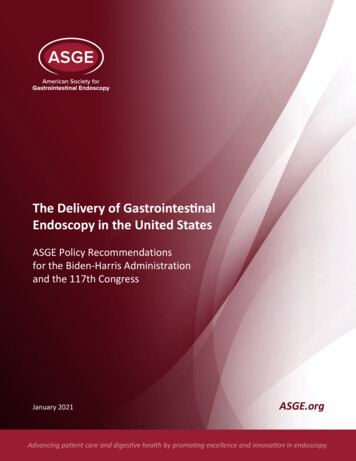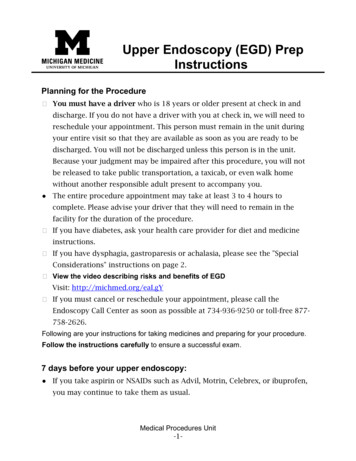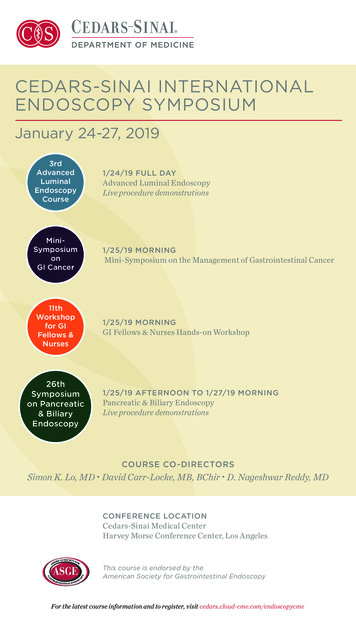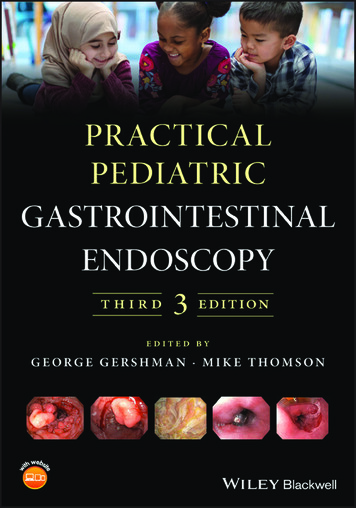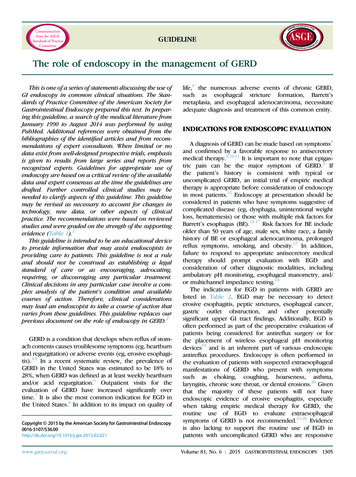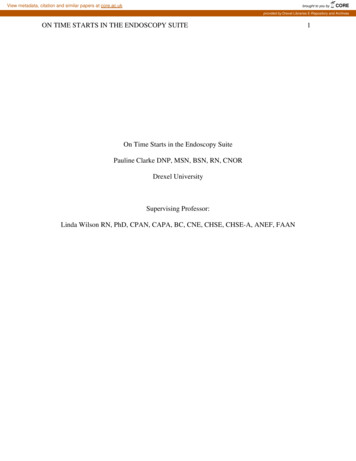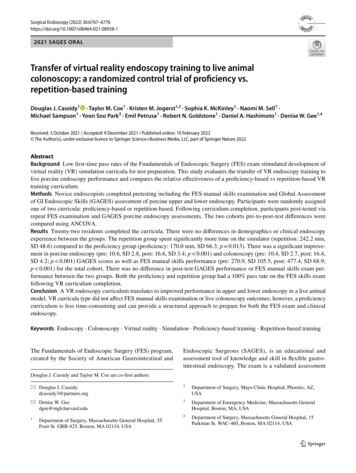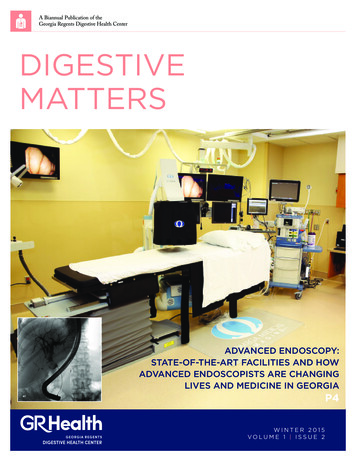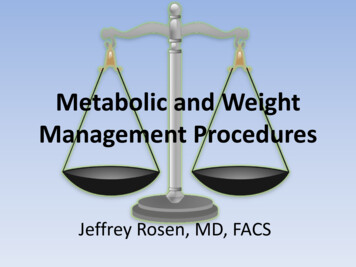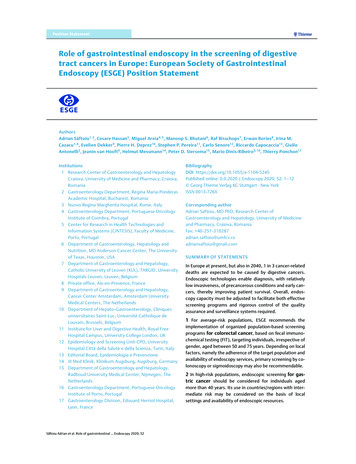
Transcription
Position StatementRole of gastrointestinal endoscopy in the screening of digestivetract cancers in Europe: European Society of GastrointestinalEndoscopy (ESGE) Position StatementAuthorsAdrian Săftoiu1, 2, Cesare Hassan 3, Miguel Areia4, 5, Manoop S. Bhutani 6, Raf Bisschops 7, Erwan Bories8, Irina M.Cazacu 1, 6, Evelien Dekker9, Pierre H. Deprez 10, Stephen P. Pereira11, Carlo Senore 12, Riccardo Capocaccia13, GiulioAntonelli3, Jeanin van Hooft 9, Helmut Messmann14, Peter D. Siersema15, Mario Dinis-Ribeiro 5, 16, Thierry Ponchon17Institutions1 Research Center of Gastroenterology and HepatologyCraiova, University of Medicine and Pharmacy, Craiova,Romania2 Gastroenterology Department, Regina Maria-PonderasAcademic Hospital, Bucharest, Romania3 Nuovo Regina Margherita Hospital, Rome, Italy4 Gastroenterology Department, Portuguese OncologyInstitute of Coimbra, Portugal5 Center for Research in Health Technologies andInformation Systems (CINTESIS), Faculty of Medicine,Porto, Portugal6 Department of Gastroenterology, Hepatology andNutrition, MD Anderson Cancer Center, The Universityof Texas, Houston, USA7 Department of Gastroenterology and Hepatology,Catholic University of Leuven (KUL), TARGID, UniversityHospitals Leuven, Leuven, Belgium8 Private office, Aix-en-Provence, France9 Department of Gastroenterology and Hepatology,Cancer Center Amsterdam, Amsterdam UniversityMedical Centers, The Netherlands10 Department of Hepato-Gastroenterology, Cliniquesuniversitaires Saint-Luc, Université Catholique deLouvain, Brussels, Belgium11 Institute for Liver and Digestive Health, Royal FreeHospital Campus, University College London, UK12 Epidemiology and Screening Unit-CPO, UniversityHospital Città della Salute e della Scienza, Turin, Italy13 Editorial Board, Epidemiologia e Prevenzione14 III Med Klinik, Klinikum Augsburg, Augsburg, Germany15 Department of Gastroenterology and Hepatology,Radboud University Medical Center, Nijmegen, TheNetherlands16 Gastroenterology Department, Portuguese OncologyInstitute of Porto, Portugal17 Gastroenterology Division, Edouard Herriot Hospital,Lyon, FranceSăftoiu Adrian et al. Role of gastrointestinal Endoscopy 2020; 52BibliographyDOI https://doi.org/10.1055/a-1104-5245Published online: 0.0.2020 Endoscopy 2020; 52: 1–12 Georg Thieme Verlag KG Stuttgart · New YorkISSN 0013-726XCorresponding authorAdrian Saftoiu, MD PhD, Research Center ofGastroenterology and Hepatology, University of Medicineand Pharmacy, Craiova, RomaniaFax: gmail.comS U M M A RY O F S T AT E M E N T SIn Europe at present, but also in 2040, 1 in 3 cancer-relateddeaths are expected to be caused by digestive cancers.Endoscopic technologies enable diagnosis, with relativelylow invasiveness, of precancerous conditions and early cancers, thereby improving patient survival. Overall, endoscopy capacity must be adjusted to facilitate both effectivescreening programs and rigorous control of the qualityassurance and surveillance systems required.1 For average-risk populations, ESGE recommends theimplementation of organized population-based screeningprograms for colorectal cancer, based on fecal immunochemical testing (FIT), targeting individuals, irrespective ofgender, aged between 50 and 75 years. Depending on localfactors, namely the adherence of the target population andavailability of endoscopy services, primary screening by colonoscopy or sigmoidoscopy may also be recommendable.2 In high-risk populations, endoscopic screening for gastric cancer should be considered for individuals agedmore than 40 years. Its use in countries/regions with intermediate risk may be considered on the basis of localsettings and availability of endoscopic resources.
Position Statement3 For esophageal and pancreatic cancer, endoscopicscreening may be considered only in high-risk individuals:– For squamous cell carcinoma , in those with a personalhistory of head/neck cancer, achalasia, or previous causticinjury;– For Barrett’s esophagus (BE)-associated adenocarcinoma, in those with long-standing gastroesophageal refluxSOURCE AND SCOPEThis Guideline is an official statement of the European Society of Gastrointestinal Endoscopy (ESGE), reviewing therole of gastrointestinal (GI) endoscopy in the early diagnosis and prevention of GI cancers.IntroductionMostly because of the aging population and environmental riskfactors, gastrointestinal (GI) cancers represent a significantburden for European citizens, comprising one quarter of all themalignancies diagnosed in Europe. An estimated 600 000 casesof GI cancer and 360 000 related deaths per year occur in theEuropean Union [1]. Moreover, when diagnosed in a symptomatic phase, most GI cancers are still associated with a dismalprognosis. The 5-year survival, as estimated for 2000–2007,was 41 % overall, varying according to site of diagnosis: 12 %for esophagus, 24 % for stomach, 48 % for colorectum, and 6 %for pancreas [1]. In addition, late-stage cancers represent aneconomic and financial burden because of palliative treatmentand new biological treatments for advanced disease.Better understanding of the natural history of GI cancers hasshown that most of them are preceded by slowly progressingprecancerous conditions or lesions, as well as by early invasivestages, therefore providing opportunities for effective interventions. Beyond the classic adenoma–carcinoma sequencefor colorectal carcinogenesis, similar pathways based onmetaplasia–dysplasia–cancer progression have been shown forupper GI as well as pancreatic cancers. In addition, advances inknowledge about genetic factors have led to the identificationof the pathogenetic mutations responsible for familial GIcancer syndromes.In this area, the application of endoscopic techniques to theGI tract, i. e., gastrointestinal endoscopy, represents a set ofunique technologies for early detection of cancer or precursors,followed by potential endoscopic interventions. In fact, endoscopic resection of precancerous and early lesions has beenassociated with reduction of incidence and very high 5-year survival rates. Besides, it is usually preferred by patients because itis less invasive and less costly than surgical treatments. Moreover, endoscopic and histological diagnosis of precancerousconditions leads to an effective risk stratification of the endos-disease symptoms (i. e., 5 years) and multiple risk factors(age 50 years, white race, male sex, obesity, first-degreerelative with BE or esophageal adenocarcinoma [EAC]).– For pancreatic cancer screening , endoscopic ultrasound may be used in selected high-risk patients such asthose with a strong family history and/or genetic susceptibility.copy population, with appropriate adjustment of surveillanceprotocols to those high-risk patients who may benefit the most.In this document, ESGE aims to summarize its position regarding the current role of endoscopy in screening for the diverse gastrointestinal neoplasms, and to support the role of digestive endoscopy in the reduction of cancer incidence andmortality. Discussion of the organization of screening programs lies outside the scope of this Position Statement, whilstalternatives to endoscopy will be briefly considered. In fact, despite the substantial developments in our own field and significant relevant evidence for the impact of endoscopy, as brieflystated above, lack of awareness by other stakeholders maylead to underuse or poor resourcing of health facilities involvedin providing screening services, with consequent failure to fullyrealize the potential benefits to patients.MethodsIn 2017, the European Society of Gastrointestinal Endoscopy(ESGE) Governing Board established a task force (Public AffairsWorking Group led by A.S.) to produce a Position Statementconcerning the value of endoscopy for screening purposes inGI cancers. The most prevalent digestive cancers (esophagealsquamous cell carcinoma, esophageal adenocarcinoma, gastriccarcinoma, colorectal cancer, and pancreatic cancer) were considered.A BB R E VI AT I rett’s esophaguscomputed tomographyesophageal adenocarcinomaEuropean Society of Gastrointestinal Endoscopyendoscopic ultrasoundfecal immunochemical testingfecal occult blood testgastroesophageal reflux diseasegastrointestinalmagnetic resonance cholangiopancreatographymagnetic resonance imagingpopulation/patient, intervention/indicator,comparator/control, outcomesquamous cell carcinomarandomized controlled trialSăftoiu Adrian et al. Role of gastrointestinal Endoscopy 2020; 52
Using a structured PICO framework (population/patient, intervention/indicator, comparator/control, outcome), detailedliterature searches were performed by an expert task force,yielding results, through a modified Delphi process, that aresummarized in recommendations/statements. The PICO itemswere defined regarding the role, in terms of prevention, survival, and cost–effectiveness (outcomes) of digestive endoscopytechnologies (upper gastrointestinal endoscopy, colonoscopy,and endoscopic ultrasound [EUS]; interventions and comparators) in two different settings (populations/patients), namelyfor the average-risk population and for high-risk groups/settings defined by geography, ethnicity, individual exposure, orfamily history. This excludes the specific management of individuals with known hereditary colorectal cancer syndromes orwith known precancerous gastric lesions, as considered in previous ESGE Guidelines [2, 3].Epidemiological data were taken from online databasesavailable from international studies. Pooled national estimateshave been used, derived from European incidence and mortality data in 2018 provided by the Joint Research Center andEuropean Network of cancer registries [4]. Incidence timetrends in 2004–2010 are based on observed rates from a poolof population-based cancer registries and are available fromthe same database. Histology-specific data for esophageal cancer were available from the RARECARENet database on incidence and survival for rare tumors in Europe [5]. Survival datawere downloaded from the EUROCARE-5 project database [1].Role of digestive endoscopy for average-riskpopulations: colon cancerSTAT EMENTFor colorectal cancer, ESGE recommends the implementation of organized population-based screening programs for average-risk populations based on fecal immunochemical testing (FIT), targeting individuals, irrespective of gender, aged between 50 and 75 years. Dependingon local factors, namely the adherence of the target population and availability of endoscopy services, primaryscreening by colonoscopy or sigmoidoscopy may also berecommendable.Frequency and pathogenesis: colorectal cancerColorectal cancer (CRC) represents the second commonestcause of cancer morbidity and mortality in Europe, with an estimated 380 000 new cases and 175 000 related deaths in 2018[6]. CRC is uniquely suited for screening programs comparedwith other GI cancers as it has detectable precursor lesions(adenomatous polyps) resection of which decreases the incidence and prevalence of CRC, with a consequent reduction inmortality.Săftoiu Adrian et al. Role of gastrointestinal Endoscopy 2020; 52Target population: CRC screeningMost screening programs include the general population aged50 to 75 years. The range may vary according to availability ofresources. In the US, because of increased incidence of CRC inyoung adults, the target group was recently expanded to include individuals aged 45 and older. The same trend in incidence of CRC has been seen in Europe over the last 25 years [7].Role of endoscopyScreening of average-risk individuals by fecal occult blood testing (FOBT) followed by colonoscopy for positive cases, and byprimary lower GI endoscopy (either colonoscopy or sigmoidoscopy) can significantly reduce CRC incidence and/or relatedmortality [8, 9]. This is the result of two effects, namely downstaging of existing CRC by early diagnosis, and prevention ofthe development of CRC by removal of precancerous polyps.For guaiac FOBT, the evidence is provided by four RCTs thatshowed an overall 24 % reduction in CRC mortality among thoseundergoing screening [9]. As FIT has a 2–3-fold higher sensitivity for detecting advanced neoplasia than the guaiac-basedtest, a greater effect of FIT-based screening is expected [10].The efficacy of primary sigmoidoscopy screening is supportedby two randomized controlled trials (RCTs) showing an overall21 % and 28 % reduction in CRC incidence and mortality, respectively, for those offered screening. The protective effects forthose actually undergoing screening were 31 % and 33 % for incidence and 38 % and 43 % for mortality [11, 12]. However, participation rates are much lower than for FIT.The efficacy of colonoscopy screening is long-lasting [13]and the test may even be performed only once in a lifetime[14, 15]. However, the long-term efficacy in preventing CRChas been associated with the quality of the screening, as reported in the ESGE document on this subject [16]. Only observational studies are available for the assessment of colonoscopyscreening, and these estimate reductions in CRC incidence andmortality of 69 % and 68 %, respectively [8]. Moreover, the population coverage with regard to opportunistic CRC screeningremains disappointingly low. In 2017, it was estimated thatonly a small minority (0.4 %–4 %) of the European populationhad undergone a colonoscopy in the previous 10 years, ascompared with over 60 % in the United States [17]. This is probably related to multifactorial barriers, including personal beliefs(e. g. lack of awareness of or fear of the screening test), organizational issues (e. g. lack of recommendation by primary carephysicians), and financial barriers [18].In Europe, according to the EU screening report, most countries have in fact implemented organized invitational screeningprograms based on FIT [19]. The main advantages of organizedversus opportunistic screening are the active invitation of alleligible individuals and the implementation of quality assurance programs. In addition, there is the potential for sendingreminders to increase participation and for proactive removalof any organizational barriers to patients’ navigation throughout the screening process. Compared with nonorganizedsettings, organized programs have also been shown to resultin high compliance with follow-up of those with a positive
Position Statementprimary screening finding, and high adherence in subsequentscreening rounds of those with a negative test result [20]. Organized screening programs, however, require several resources. Two of the most challenging aspects of an organized program are the heavy burden on the available endoscopic capacity and the high costs. The most reasonable solution for the firstproblem would be to proportionally increase the number ofendoscopists in order to match the additional burden of colonoscopies for the screening program, including for surveillancethereafter [21, 22]. In addition, to prevent unnecessary extracolonoscopies due to inappropriate indications, surveillanceguidelines should be strictly followed [23].As mentioned above, organized programs require complexorganizational activities that, considering the large variabilityin the structure of the different health systems, are not necessarily available in all European countries. Indeed, some regionsor countries in the EU have not yet implemented screeningprograms [24]. In these countries, average-risk patients mayexceptionally apply for a case-by-case or ‘opportunistic’ nonorganized screening for CRC prevention.Although CRC screening may have been implemented, theactual coverage of the target population by invitation hasshown a wide variation across the EU member states, rangingbetween 1.5 % and 100 %. Equally, participation rates vary widelyacross EU countries, resulting in an actual screening coverage of19.8 % for the entire 50–74 target age range in population-basedprograms, and 25.1 % in the age ranges targeted by the programs[25]. Although this is an underestimate (as several programscould not provide adequate data about opportunistic screeningactivities), the corresponding figure for non-population-basedprograms was as low as 4.2 % [8].Cost–effectiveness of CRC screeningThe convenience of population-based CRC screening has beenshown in several simulation models. In particular, such screening has been demonstrated to be cost-saving, or cost-neutral,because of the substantial decrease in expenditure on CRCtreatment, including biological therapy, that has been achievedby reduction in CRC incidence and by downstaging of existingcancers [26].Surveillance for individuals at increased risk of CRC becauseof personal or family CRC history has been addressed in previous ESGE Guidelines [2, 3].Role of digestive endoscopy for high- andintermediate-risk populations: gastric cancerSTAT EMENTIn high-risk populations, endoscopic screening for gastric cancer should be considered for individuals agedmore than 40 years. Its use in countries/regions with intermediate risk may be considered on the basis of localsettings and availability of endoscopic resources.Epidemiology: gastric cancerGastric cancer is the fifth most common malignancy and thethird leading cause of cancer death worldwide [27]. Gastric cancer incidence is decreasing in developed countries, but it is stillresponsible for about 80 000 new cases per year in the EU, withan incidence of 16 per 100 000 per year. Even though gastriccancer can be recognized and treated at an early point, mostof these cancers are still diagnosed late, with an overall 5-yearsurvival of 24 %. Nevertheless, mortality might be reduced by40 %, with early detection by means of screening [28, 29].Gastric cancer screening is intended for the intestinal typeof gastric cancer, that represents more than 95 % of all gastriccancers and is the final stage of the inflammation–metaplasia–dysplasia–carcinoma sequence known as the Correa cascade[29]. The diffuse type of gastric cancer has a different carcinogenetic sequence and screening is not indicated. Currently,screening for intestinal-type gastric cancer is only performedin countries with a high disease incidence, defined as an agestandardized rate 20 per 100 000, such as Japan or South Korea (29.9 and 41.3 per 100 000, respectively) [30, 31]. Screeningenables detection of gastric cancer at earlier stages, even of theearly gastric cancers defined as carcinoma limited to the mucosaor submucosa, regardless of lymph node involvement; in otherwords lesions amenable to curative endoscopic treatment suchas endoscopic submucosal dissection [32, 33].Target population: gastric cancerAll the screening studies are from Asia and most have used theage range 40–80 years since most gastric adenocarcinomas arediagnosed after the age of 40 years. This is similar to (althoughwider than) the 50–75-year range of the European colorectalcancer screening recommendation [28, 34].Patients with family history, pernicious anaemia, previouspartial gastrectomy, or in other subgroups, lie outside thescope of the present statement and should follow specificrecommendations.Role of endoscopy (upper GI endoscopy)In high-risk areas (defined as having an age-standardized rate 20 per 100 000), endoscopy has a clear role for primaryscreening. The interval between examinations with negativefindings varies among studies but most reported annual or biennial endoscopies [28]. Also in these regions, serologicscreening based on pepsinogen testing has been promotedand its effectiveness demonstrated [34–36].For regions with an age-standardized mortality rate for gastric cancer of 10 per 100 000, endoscopic screening for theentire population is not recommended [37].For intermediate-risk regions, with an age-standardized ratebetween 10 and 20 per 100 000, endoscopy may have a role forprimary screening if cost–effectiveness is proven in the particular country. The interval between negative exams might beevery 5 years [38].Săftoiu Adrian et al. Role of gastrointestinal Endoscopy 2020; 52
Cost–effectiveness of screening for gastric cancerEpidemiology: SCCSeveral studies concluded that endoscopic screening is costeffective in high-incidence regions [39–43]. Indeed, the twomost recent studies, both for the Korean population, concludedthat endoscopic screening is cost-effective. Studies indicatedthat either annual screening for men and biennial for women,for a population aged 50–80 years, or annual screening in patients older than 40 years is cost-effective [42–44].In Europe, one study compared three screening strategies:stand-alone upper endoscopy; endoscopy combined with aCRC screening colonoscopy after a positive FOBT result; andpepsinogens serologic screening. It concluded that an endoscopic gastric cancer screening every 5 years was cost-effectiveonly if combined with a screening colonoscopy [38]. This meansthat in Europe, if a colorectal cancer screening program is already in place (by means of FOBT or stand-alone colonoscopy)all countries with an intermediate incidence rate of gastric cancer, such as Albania, Belarus, Macedonia, Russia, Latvia,Ukraine, Estonia, Lithuania, Portugal, Moldova, Romania, Slovenia, Bulgaria, and Croatia (presented according to their agestandardized rate, from 20.1 to 10.3), might benefit by providing a screening upper endoscopy in conjunction with colonoscopy for their populations. Although prospective studies onthe use of pepsinogen serology as a screening method are ongoing in some European countries, its high cost and limitedavailability outside Asia are the main limitations from a cost–effectiveness and practical perspective; as such, it cannot be recommended at the moment [3, 35].In the East, three other studies concluded that an endoscopic mass screening every 2 years was only cost-effective inhigh-risk individuals aged 50–70 years with an odds ratio forgastric cancer risk of 3.9, but not for the entire population[43, 45, 46].Only two studies in low-risk scenarios (USA) had been published, and these concluded that gastric cancer incidencewould have to increase by 337 % for screening to become costeffective [47, 48].Surveillance for individuals at increased risk of gastric cancerbecause of a personal history of precancerous conditions or lesions has been addressed in previous ESGE Guidelines.Esophageal cancer is the seventh most commonly occurringcancer in men and 13th most common in women [49]. Globally,SCC accounts for the majority of the cases of esophageal canceralthough its proportion relative to adenocarcinoma varies fromcountry to country, being on average approximately 1 : 1 in theEU. In 2013 it was estimated that there were about 19 200 newSCC diagnoses per year in the EU. Over the past three decades,a consistent decline in the rates of esophageal SCC has beenobserved in Western Europe and a stable rate or slower declinein central European countries. On the other hand, an increase inSCC incidence has been reported in Eastern European countries. The decline in SCC incidence in Western Europe has beenmainly attributed to the reduction in alcohol consumption andsmoking habits. SCC survival is low, being 38 % at 1 year and12 % at 5 years after diagnosis [5].Role of digestive endoscopy in high-risksettings: esophageal cancerSquamous cell carcinoma (SCC)STAT EMENTEndoscopic screening for squamous cell carcinomashould only be considered in high-risk individuals or patients (opportunistic): i. e., in those with a personal history of head/neck cancer, achalasia, or previous causticinjury.Săftoiu Adrian et al. Role of gastrointestinal Endoscopy 2020; 52Target population: SCCIn moderate- and lower-risk Western countries, the most important risk factors are the combination of tobacco smoking and excessive alcohol consumption [50]. Unlike adenocarcinoma,esophageal SCC is 3 to 5 times more likely among people whoconsume alcohol (3 or more drinks daily), and the risk increasessynergistically with tobacco smoking. SCC screening in moderate- and lower-risk countries would include an excessively largepopulation at risk and therefore seems impractical. Screening istherefore usually proposed to small subgroups of patients atvery high risk, such as those with a previous or concomitantdiagnosis of head/neck SCC [51], achalasia (up to 10 timesrisk) [52], previous radiotherapy for breast cancer, history ofhead/neck cancer, previous caustic injury to the esophagus,and tylosis [53].There is no specific recommendation on the best time tostart screening for SCC. For high-risk factors, achalasia is agood example of the absence of consensus, although the absolute risk increase for SCC was 308.1 per 100 000 patients peryear, suggesting a strict endoscopic surveillance for these patients. But in practice, no consensus has been reached amongworld experts with regard to timing: practices are still varied,with screening commencing at or within 1 year of diagnosis insome cases compared with 5 and 10 years in others. Surveillance intervals also vary, from 2 to 5 years [54].Role of endoscopy: SCCPrecancerous dysplastic lesions are detectable using endoscopyand noninvasive screening methods; however routine screening is currently not recommended outside high-risk areas orfor low-risk individuals [55]. Endoscopy remains the gold standard for diagnosis of dysplasia and early SCC but it is invasive andexpensive, and therefore alternative approaches to broaden thetest population are of interest. Since serologic tests are notclinically available yet, other invasive but less costly tests areneeded to diagnose SCC or premalignant lesions, such asexfoliative cytology [56].
Position StatementCost–effectiveness: SCCTarget population: BE and EACThere are very few studies about the cost–effectiveness of SCCscreening, compared with Barrett’s esophagus screening andsurveillance. A cost–benefit analysis studied standard endoscopic screening strategies for esophageal cancer in high-riskareas of China. The authors found that, compared with noscreening, all screening strategies with varying screening ages,frequencies, and follow-up intervals could save more life-years[57]. A recent study used a decision-analytic Markov model tostudy the cost–effectiveness of incorporating high resolutionmicroendoscopy into an SCC screening program in China, withresults showing that it could be cost-effective [58].There are no European studies suggesting that endoscopicscreening for SCC is either necessary or cost-effective. The lowincidence of SCC in the European population and the predominance of public health systems might be some of the main reasons why screening for this condition is not an option even inindividuals with risk factors. Interestingly, if screening for SCCin the Western world was extended to Barrett’s cancer andgastric cancer combined, by performing a single upper endoscopy at the time of screening colonoscopy, it might be a costeffective method to screen for multiple cancers simultaneously, with an incremental cost–effectiveness ratio comparingfavorably with commonly performed screening strategies forother cancers [47].Screening for BE or EAC by endoscopic and nonendoscopicmethods is not recommended for the general population, because of the relatively low risk. The screening population needsto be enriched by high-risk individuals for screening to be costeffective [70].Epidemiological studies have identified risk factors for BEand EAC. The main risk factors for BE are gastroesophageal reflux disease (GERD), obesity, male sex, older age, and cigarettesmoking [62]. GERD is the strongest established risk factor forBE and EAC, with symptoms that have been present for 10 yearsbeing especially associated with development of EAC [61, 70].BE is more common in men than in women, and amongpatients with BE there is a 2–3 times higher transformation toEAC in men than women [61]. BE becomes more common withage, and the risk becomes substantial in men older than 60years who have GERD symptoms [71]. The presence of intestinal metaplasia (i. e., goblet cells) is a risk factor for evolutionto neoplasia [63], and is a requirement for fulfilling the ESGEdefinition of BE. Other risk factors for conversion from BE toEAC are the presence of dysplasia or long-segment BE [63].Barrett’s esophagus (BE) and esophagealadenocarcinoma (EAC)STAT EMENTEndoscopic screening for Barrett’s esophagus (BE)associated adenocarcinoma should only be consideredin high-risk individuals or patients (opportunistic): i. e.,in those with long-standing gastroesophageal reflux disease symptoms (i. e., 5 years) and multiple risk factors(age 50 years, white race, male sex, obesity, first-degree relative with BE or esophageal adenocarcinoma).Epidemiology: BE and EACEsophageal cancer has a poor 5-year survival of less than 15 %[59, 60]. Moreover, there has been a striking increase in the incidence of EAC and associated death in most Western countriesover the past 30 years [61, 62]. BE is a premalignant conditionfor the development of EAC, characterized by the replacementof the normal squamous epithelium above the gastroesophagealjunction with columnar epithelium [63, 64]. The prevalence ofBE in the general population has been estimated to be 1 % to 2 %[65, 66]. The annual risk of BE converting to EAC, after excluding the cases diagnosed during the first year, is 0.12 % to 0.50 %[67, 68]. Because of this pre-existing condition, EAC can potentially be prevented by screening for this precursor lesion.Screening age: BE and EACIn view of the abovementioned established risk factors, ESGErecommends endoscopic screening after the age of 50–60years (according to local availability) for patients who havechronic GERD symptoms for more than 5–10 years [72]. Thereason why screening high-risk individuals might be beneficiallies in the epidemiological findings that the majority of esophageal cancers are de
carcinoma, colorectal cancer, and pancreatic cancer) were con-sidered. 3 For esophageal and pancreatic cancer, endoscopic screening may be considered only in high-risk individuals: - For squamous cell carcinoma, in those with a personal history of head/neck cancer, achalasia, or previous caustic injury;
